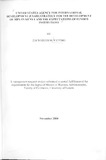| dc.description.abstract | The micro finance sector in Kenya has grown rapidly in the last ten years. The sector has
grown out of necessity primarily to provide financial services to the micro-economy,
comprising all segments of the rural and urban population, including small scale farmers,
microentrepreneurs, women and the poor.
The sector has grown largely through the support of development organizations in which
the United States Agency for International Development (USAID) is among the leading
donor agencies. This case study is to examine the factors that influence the USAID MFI
development strategy, the expectations of the USAID- supported MFIs and a comparison
of the USAID - MFI expectations.
The study had three objectives:
1. Establish how USAID's expectations influence its MFI development strategy for
the sector in Kenya.
2. Identify the expectations/perceptions of MFIs supported by USAID.
3. Establish a comparison of USAID and MFI expectations.
Data was collected through questionnaires administered personally and circulated to
MFIs. Both closed and open-ended questions were used. Data was collected from 7
USAID officials and 7 MFIs that have been directly funded by USAID over the last ten
years. Secondary data was also used in the analysis. Basic statistical analysis such as
frequency distribution, simple and cross tabulations, proportions and percentages were
used. A content analysis was also carried out.
USAID has an MFI development strategy that shows that the future of microfinance lies
not with limited donor funds, but with the private sector. In other words, microfinance
services should become part of the country's private financial system in order to be
sustainable. The strategy is highly influenced by pre-determined expectations that have
been jointly agreed upon by many donor agencies through the Consultative Group to
Assist the Poor (CGAP). The results also show that MFIs have the same expectations as
donors and no major standing out controversy was noted in the study.
On the part of MFIs, there is a general consensus that if they are to grow enough to reach,
on a long-term basis, the millions of low income people without access to financial
services, they need access to more sustainable sources of finance to support their
development. These will have to include private sources of debt and equity and savings.
There is still a role for donors in further development of the microfinance industry in
Kenya to address a number of constraints including lack of capital for on-lending and
institutional capacity of MFIs.
In spite of the sustainability and even profits that have been reported by MFIs, there are
few signs that the micro finance industry in Kenya has evolved into a real business that
will grow and reach more low-income people without subsidy, whether it is given by
foreign donor agencies, national governments or charities. This is partly because
microfinance is still perceived as subsidy-dependent activity, and the continuing flow of
donor funds 'crowd-out' profit seeking finance. The study shows that there is little sign
that start-up capital is flowing to micro finance. The MFIs' intentions and strategy of less
reliance on donor funding will be tested over time.
The enactment of the Microfinance legislation to allow qualifying MFls mobilize
deposits from the public is absolutely necessary. The Bill should be enacted without
delay. Savings is a viable source of capital for on-lending purposes to many MFls that
are presently registered as NGOs or finance companies. In addition, the Microfinance
legislation will enable MFls develop other financial services that are appropriate for the
majority of the rural population.
A policy and regulatory framework for MFls and pro-poor programs is required. The
policy framework will address a number of issues about pro-poor financial services and
programs such as awareness and education, establishment of appropriate support
institutional framework such as an MFI fund to support the industry, establishing a legal
framework that ensures that courts are effective in the collection of debts. | en |

